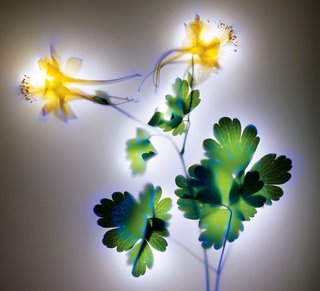Wednesday, July 22, 2009
High Voltage Photography
I recently read about this guy Robert Buelteman and is unique photos in my Wired magazine. At first glance I thought the pictures we good but as I read the article and looked at them again they seemed even more impressive.

“Buelteman's technique is an elaborate extension of Kirlian photography (a high-voltage photogram process popular in the late 1930s) and is considered so dangerous and laborious that no one else will attempt it—even if they could get through all the steps.
Buelteman begins by painstakingly whittling down flowers, leaves, sprigs, and twigs with a scalpel until they're translucent. He then lays each specimen on color transparency film and, for a more detailed effect, covers it with a diffusion screen. This assemblage is placed on his "easel"—a piece of sheet metal sandwiched between Plexiglas, floating in liquid silicone. Buelteman hits everything with an electric pulse and the electrons do a dance as they leap from the sheet metal, through the silicone and the plant (and hopefully not through him), while heading back out the jumper cables. In that moment, the gas surrounding the subject is ionized, leaving behind ethereal coronas. He then hand-paints the result with white light shining through an optical fiber the width of a human hair, a process so tricky each image can take up to 150 attempts.”

“Buelteman's technique is an elaborate extension of Kirlian photography (a high-voltage photogram process popular in the late 1930s) and is considered so dangerous and laborious that no one else will attempt it—even if they could get through all the steps.
Buelteman begins by painstakingly whittling down flowers, leaves, sprigs, and twigs with a scalpel until they're translucent. He then lays each specimen on color transparency film and, for a more detailed effect, covers it with a diffusion screen. This assemblage is placed on his "easel"—a piece of sheet metal sandwiched between Plexiglas, floating in liquid silicone. Buelteman hits everything with an electric pulse and the electrons do a dance as they leap from the sheet metal, through the silicone and the plant (and hopefully not through him), while heading back out the jumper cables. In that moment, the gas surrounding the subject is ionized, leaving behind ethereal coronas. He then hand-paints the result with white light shining through an optical fiber the width of a human hair, a process so tricky each image can take up to 150 attempts.”
.jpg)